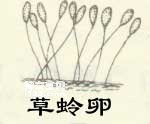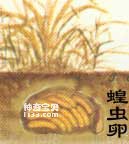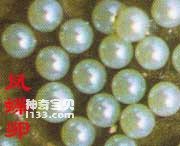The egg is the first insect state in the ontogeny of oviparous insects; the egg is a large cell composed of several parts. The outermost surface of the egg is the egg shell, which is generally relatively hard and functions to protect the egg cells. Egg shells are complex protein structures. Inside the egg shell is a thin film called the vitelline membrane. Wrapped inside the vitelline membrane is protoplasm and rich yolk. The yolk fills the gaps in the protoplasm network, but there is no yolk in the protoplasm close to the inner surface of the vitelline membrane, so this part of the protoplasm is called periplasm. The egg nucleus is usually located in the center of the egg, but moves to the periphery of the fertilization hole when fertilization is about to occur. After fertilization, the nucleus begins to divide, and then undergoes a series of changes to form an embryo, and finally a living larvae that emerges from the egg shell. Therefore, embryonic development and the formation of young life take place in the egg shell. The fertilization pore or egg hole mentioned earlier is located at the front end of the egg. It is one or several small holes that penetrate the egg shell. It is the passage for sperm to enter the egg during fertilization. There are often various carvings around the fertilization hole, some are radial, some are petal-shaped or chrysanthemum-shaped, which are very beautiful when viewed under a dissecting microscope. Don't underestimate these insignificant carvings, they are still a very important basis for distinguishing different types of insect eggs.
It is an objective fact that there are many types of insects. In this diverse group, the shapes of egg cells are also diverse. The eggs vary in size and color. The methods of laying eggs and the places where they are laid are also various. It is like eight immortals crossing the sea, each showing his magical powers. However, this is not because they deliberately want to be original and unconventional, but rather determined by their different living environments and habits. In terms of living environment, there are terrestrial, aquatic, cave-dwelling, ectoparasitism, internal parasitism, etc.; in terms of food habits, there are also herbivorous, carnivorous, saprophagous, coprophagous, etc. When laying eggs, they not only have to choose an environment that is convenient for their children to live in, but also consider the convenience of their children to eat after they are born, so they lay their eggs on plants, animals or other objects that the larvae can eat as soon as they are born. Some species also consider the safety of their children, laying eggs in hidden places, or covering the eggs with hairs removed from their own bodies, so that they are not easily discovered by natural enemies. It is for these reasons that collecting and identifying eggs is difficult. But as long as you work hard and gradually accumulate, it is not too difficult to master and understand some common insect eggs. Due to space limitations, only a few common and representative insect eggs are introduced here.

The eggs of stink bugs are almost the same at the top and bottom, and are slightly thicker in the middle. They are most likely to be like drums or barrels. The surface of the egg shell has obvious annular patterns and carved points of different shapes. There is a cover (egg cover) on the top that is convenient for the nymphs to drill out when they hatch. There is a circle of small fence-like spines or balls on it. The egg shell around the egg cover is thin and easily cracked. When hatching, the nymph can open it with just a push of its head, as if opening a door in the sky, making it easier to climb out.

The eggs of lacewings have a long, filamentous handle underneath the egg. The base of the long handle sticks to the plant leaves, lifting the egg high. The eggs are at the top of the stalk and are white or light green. They are laid singly or severally on one leaf. The eggs are heavy and the silk handle is long. The handle is elastic and will sway when the breeze blows. It is very beautiful.

Head lice lay their eggs on the hair and stick the lower end of the individual eggs tightly with glue to prevent the hair from falling off. Most of the upper end of the egg extends out and does not stick to the hair. The shape of the eggs is elongated or jujube-shaped with a blunt top and a sharp bottom. There are irregularly arranged longitudinal engraved spots on the surface of the egg shell. The upper end of the egg shell is slightly flush with horseshoe-shaped carvings.

Locusts lay their eggs in the soil, burrow into the soil with a cone-shaped ovipositor, and their abdomen can be extended very long, like a drill in geological engineering. They lay their eggs in an egg bag formed by secretions, and wrap them into An egg mass with varying numbers of eggs. Each female can lay 3-5 egg masses. The eggs are long and milky white in shape.

The eggs of the mole cricket are oblong, about 2.8 mm long. They are milky white when first laid, gradually turn to yellowish brown, and turn dark purple before hatching. There are 10 to 46 eggs in each egg chamber, stacked up and down. Adults have the habit of protecting eggs.

The eggs of the green leafhopper are mostly laid on the veins of leaves or branches of trees. The female first uses a saw-like ovipositor to make a crescent-shaped crack on the leaf vein or branch, and lays 1-10 eggs in the crack, arranged neatly; the eggs are 2 mm long and o. 7 mm, long oval and slightly curved, thick at the base and slightly thin at the upper end. They are light yellow when first born, and red eyespots can be seen on the upper end when they hatch.

The white-backed planthopper lays eggs in the leaf sheath or main vein tissue of the leaf of the host plant. One to more than ten are produced at a time, arranged neatly, forming brown vertical strips on the leaf surface. It also first uses an ovipositor to scratch the leaf sheath or leaf tissue, and then lays eggs in the gap tissue. The egg is long and slightly curved, with the lower end slightly thick and rounded, and the upper end slightly thin and pointed. They are white when first born and later turn to waxy yellow.
White butterfly eggs are apricot yellow when first laid, about 0.6 mm long, and adhere upright to the leaves. The bottom is flat, the middle is slightly thick, the top is blunt and pointed, and the shape is like a small cannonball (or vase, pagoda). There are vertical and horizontal ridges on the surface of the egg shell, forming many small squares.

The eggs of corn borer are short oval, with a long diameter of 1 mm and a short diameter of 0.8 mm. They are milky white when first laid, then turn to yellowish white, with fish scales arranged into irregular egg masses.


The eggs of the swallowtail butterfly are spherical, rich in color, and often have a metallic luster. The eggs are in pieces, ranging from a few to twenty or thirty.


The eggs of the Toad moth are flat and hemispherical; the eggs of the bedbugs are like tubes; the eggs of the mantis are like thick snot stuck to the branches.
animal tags:
We created this article in conjunction with AI technology, then made sure it was fact-checked and edited by a Animals Top editor.